Abstract
The clinical and physiological effects of a medically supervised, indoor physical training programme were investigated in 36 asthmatic subjects aged 16-40 years. After clinical evaluation, lung function assessment, and progressive incremental exercise testing subjects were randomly allocated to control and training groups. The measurements were repeated after a six week run in period and after a further three months in which those in the training group underwent an indoor training programme. The measurements made at three months were compared with those at the end of the run in period. There was no significant change in anthropometric characteristics, blood lipid profiles, or the provocative concentration of histamine causing a 20% fall in FEV1 (histamine PC20) in the group who underwent training. After training there were significant increases in mean maximal oxygen uptake (ml kg-1 min-1) from 23 (5) to 28 (6), oxygen pulse (ml/beat) from 8.8 (2.3) to 10.8 (2.4), and anaerobic threshold (1/min) from 1.11 (0.27) to 1.38 (0.33). These changes were significantly greater in the group undergoing training than in the control group. There was also a significant fall in breathlessness scores (Borg ratings), blood lactate, carbon dioxide output, and minute ventilation during submaximal exercise in the training group, with no change in the control group. The subject's motivation, the initial level of fitness, and the symptom score at the time of training were the most important factors influencing improvements in cardiorespiratory fitness. Thus submaximal physical exercise of controlled intensity, sustained for three months, produced significant improvements in fitness and cardiorespiratory performance that should be advantageous to the exercising asthmatic patient. The availability of medical supervision throughout the exercise programme appears to have contributed to the successful outcome.
Full text
PDF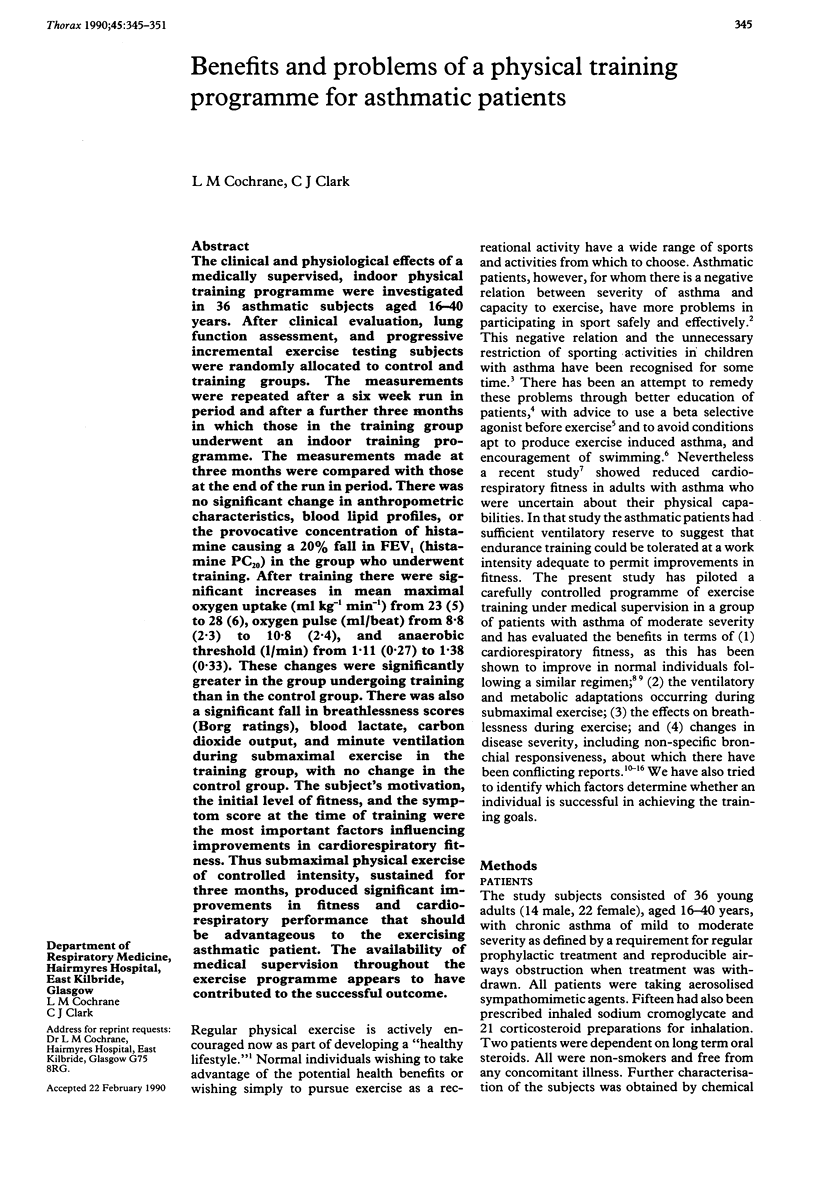
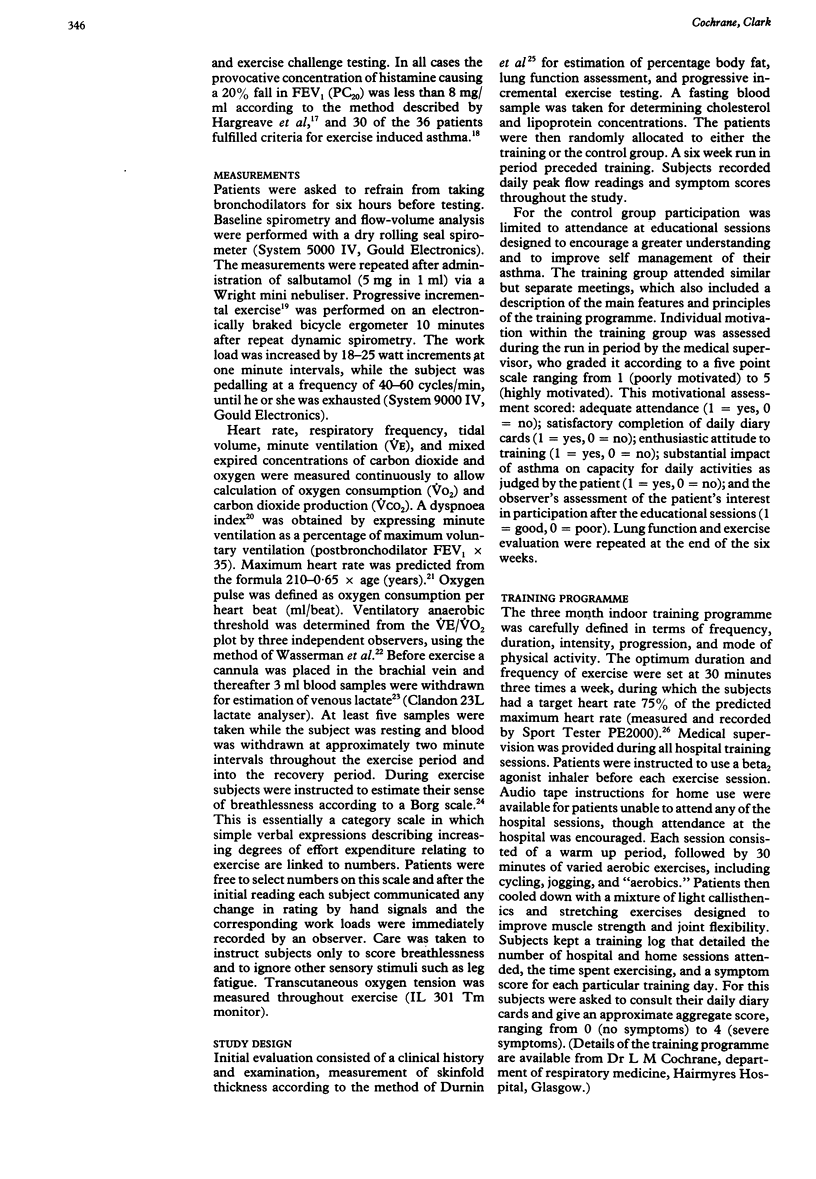
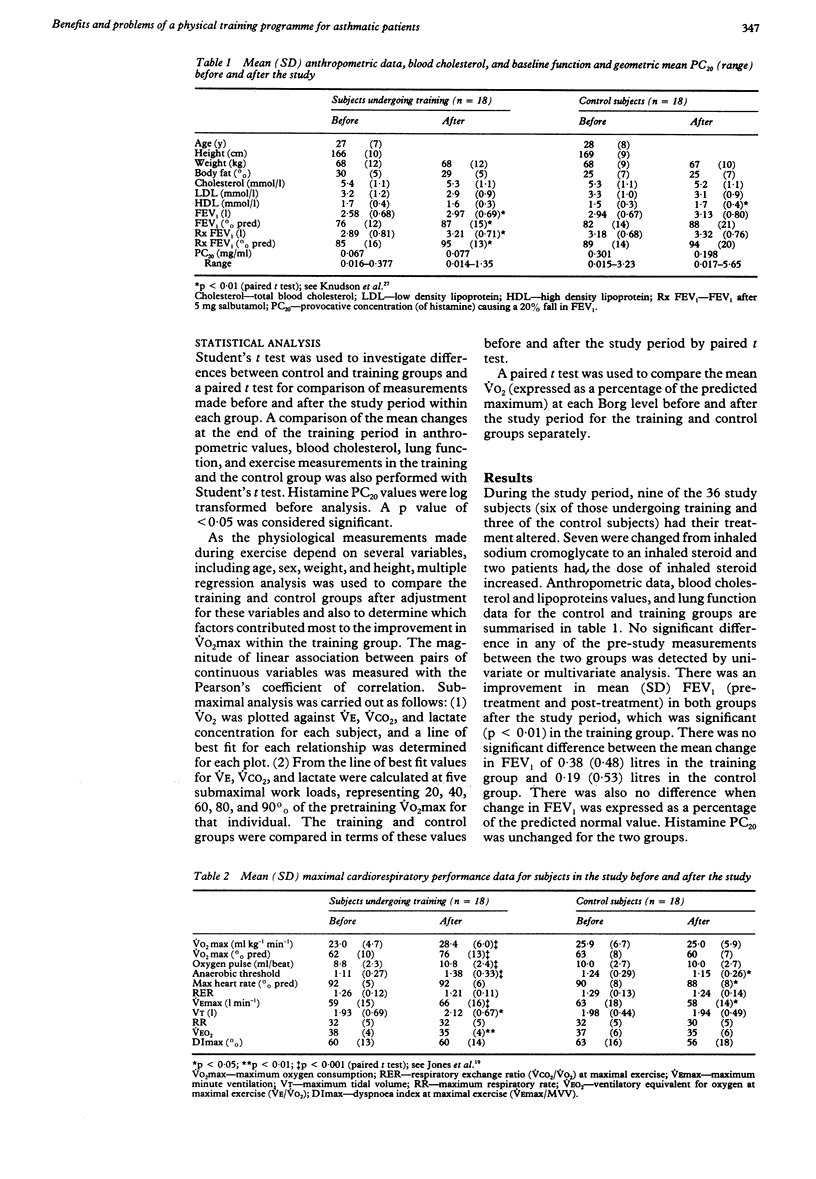
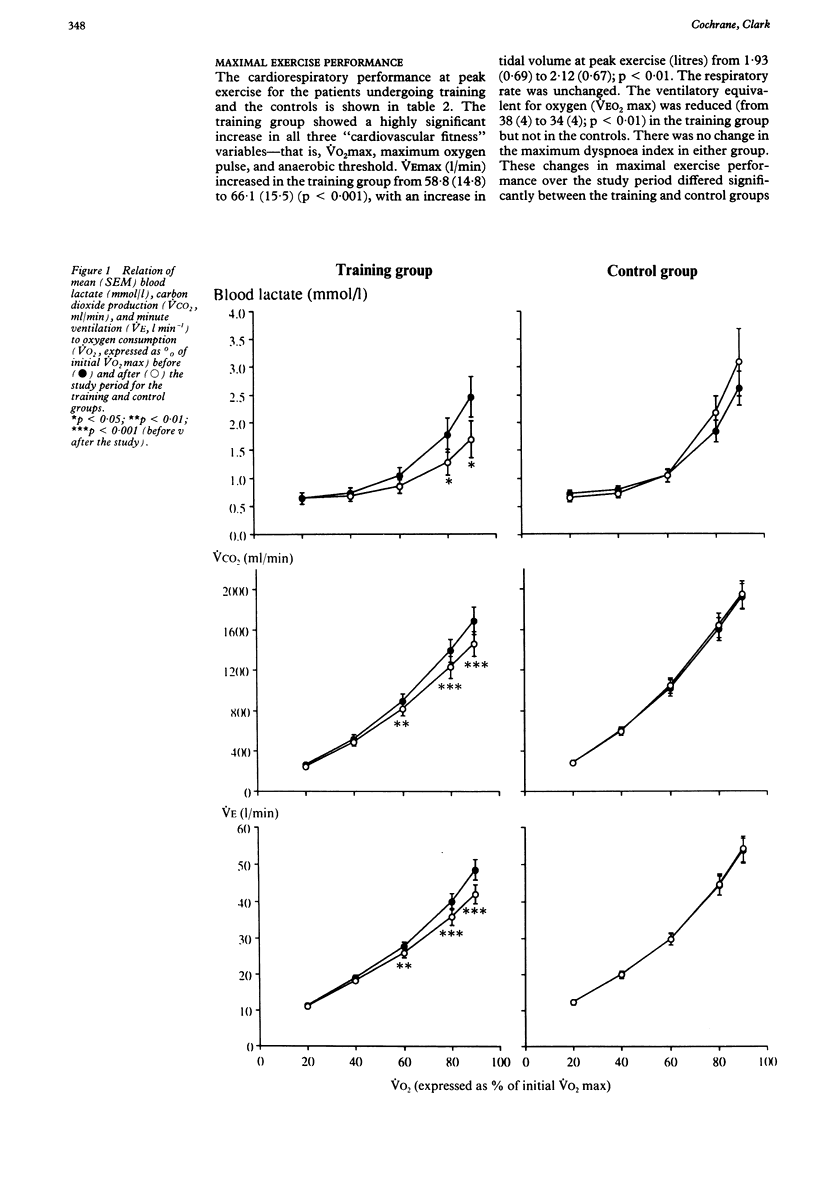
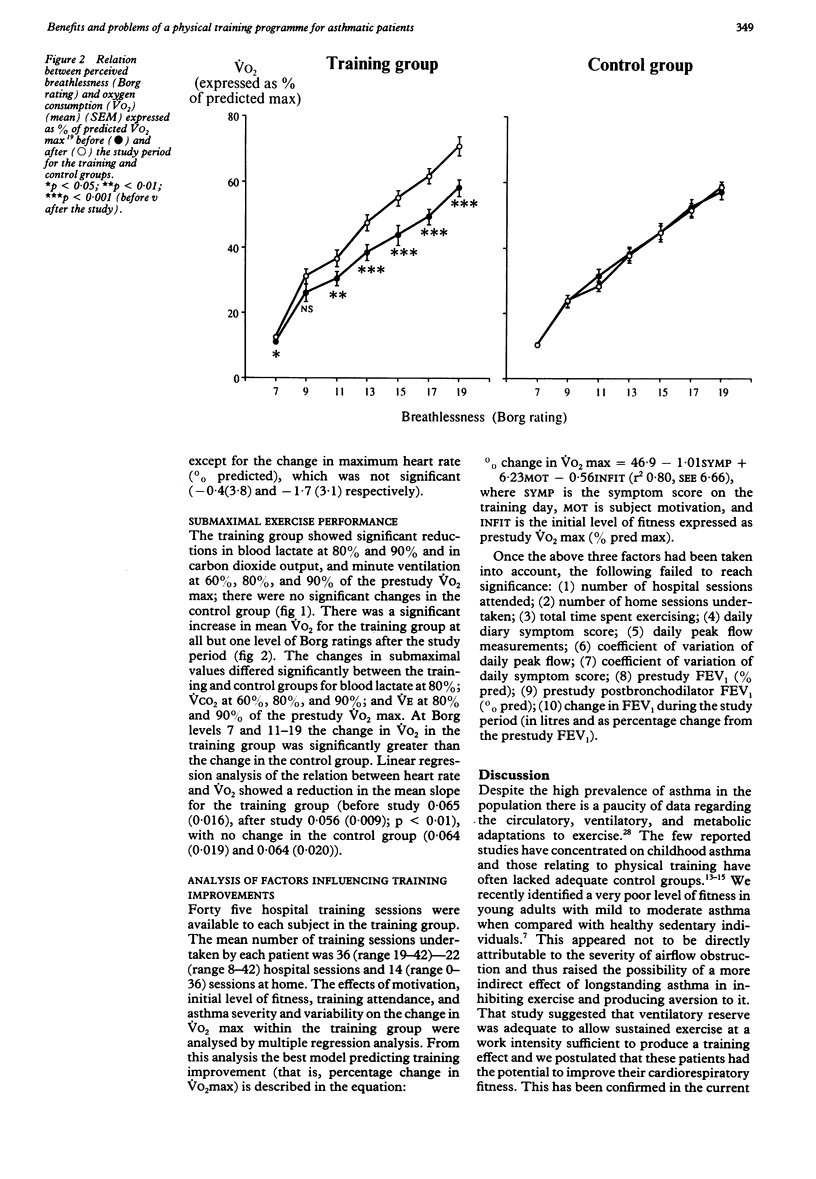
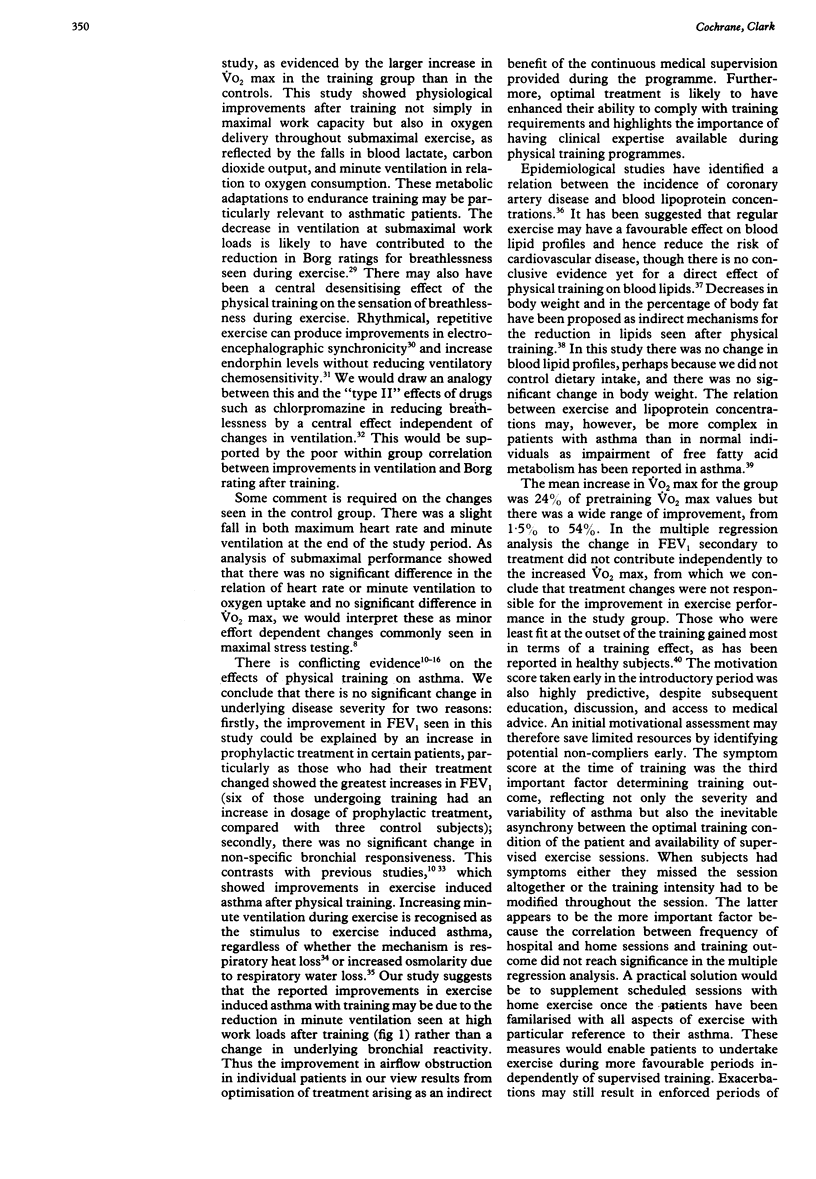
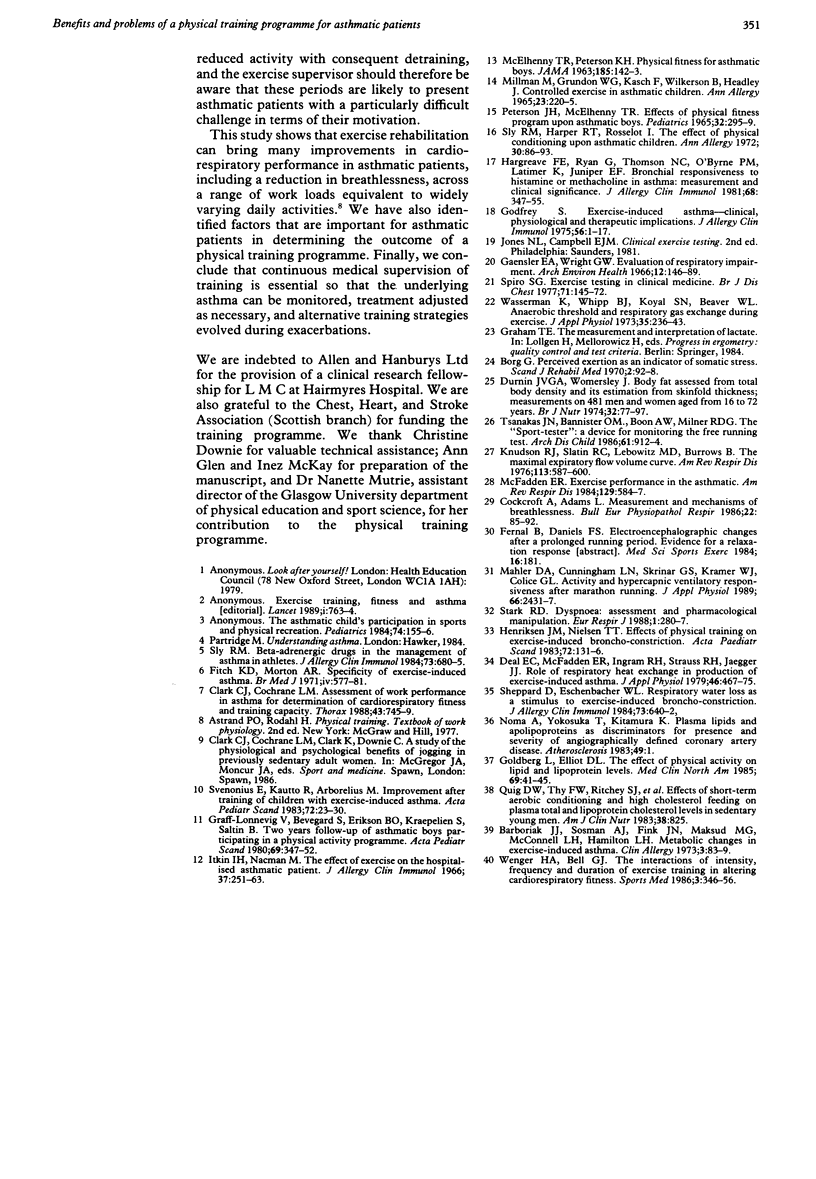
Selected References
These references are in PubMed. This may not be the complete list of references from this article.
- Barboriak J. J., Sosman A. J., Fink J. N., Maksud M. G., McConnell L. H., Hamilton L. H. Metabolic changes in exercise-induced asthma. Clin Allergy. 1973 Mar;3(1):83–89. doi: 10.1111/j.1365-2222.1973.tb01312.x. [DOI] [PubMed] [Google Scholar]
- Borg G. Perceived exertion as an indicator of somatic stress. Scand J Rehabil Med. 1970;2(2):92–98. [PubMed] [Google Scholar]
- Clark C. J., Cochrane L. M. Assessment of work performance in asthma for determination of cardiorespiratory fitness and training capacity. Thorax. 1988 Oct;43(10):745–749. doi: 10.1136/thx.43.10.745. [DOI] [PMC free article] [PubMed] [Google Scholar]
- Cockcroft A., Adams L. Measurement and mechanisms of breathlessness. Bull Eur Physiopathol Respir. 1986 Jan-Feb;22(1):85–92. [PubMed] [Google Scholar]
- Deal E. C., Jr, McFadden E. R., Jr, Ingram R. H., Jr, Strauss R. H., Jaeger J. J. Role of respiratory heat exchange in production of exercise-induced asthma. J Appl Physiol Respir Environ Exerc Physiol. 1979 Mar;46(3):467–475. doi: 10.1152/jappl.1979.46.3.467. [DOI] [PubMed] [Google Scholar]
- Dorchy H. Organ-specific antibodies in young diabetics. Acta Paediatr Scand. 1983 Jan;72(1):131–132. doi: 10.1111/j.1651-2227.1983.tb09677.x. [DOI] [PubMed] [Google Scholar]
- Durnin J. V., Womersley J. Body fat assessed from total body density and its estimation from skinfold thickness: measurements on 481 men and women aged from 16 to 72 years. Br J Nutr. 1974 Jul;32(1):77–97. doi: 10.1079/bjn19740060. [DOI] [PubMed] [Google Scholar]
- Fitch K. D., Morton A. R. Specificity of exercise in exercise-induced asthma. Br Med J. 1971 Dec 4;4(5787):577–581. doi: 10.1136/bmj.4.5787.577. [DOI] [PMC free article] [PubMed] [Google Scholar]
- Gaensler E. A., Wright G. W. Evaluation of respiratory impairment. Arch Environ Health. 1966 Feb;12(2):146–189. doi: 10.1080/00039896.1966.10664355. [DOI] [PubMed] [Google Scholar]
- Godfrey S. Exercise-induced asthma--clinical, physiological, and therapeutic implications. J Allergy Clin Immunol. 1975 Jul;56(1):1–17. doi: 10.1016/0091-6749(75)90029-9. [DOI] [PubMed] [Google Scholar]
- Goldberg L., Elliot D. L. The effect of physical activity on lipid and lipoprotein levels. Med Clin North Am. 1985 Jan;69(1):41–55. [PubMed] [Google Scholar]
- Graff-Lonnevig V., Bevegård S., Eriksson B. O., Kraepelien S., Saltin B. Two years' follow-up of asthmatic boys participating in a physical activity programme. Acta Paediatr Scand. 1980 May;69(3):347–352. doi: 10.1111/j.1651-2227.1980.tb07091.x. [DOI] [PubMed] [Google Scholar]
- Hargreave F. E., Ryan G., Thomson N. C., O'Byrne P. M., Latimer K., Juniper E. F., Dolovich J. Bronchial responsiveness to histamine or methacholine in asthma: measurement and clinical significance. J Allergy Clin Immunol. 1981 Nov;68(5):347–355. doi: 10.1016/0091-6749(81)90132-9. [DOI] [PubMed] [Google Scholar]
- Harkema J. R., Mauderly J. L., Gregory R. E., Pickrell J. A. A comparison of starvation and elastase models of emphysema in the rat. Am Rev Respir Dis. 1984 Apr;129(4):584–591. [PubMed] [Google Scholar]
- Knudson R. J., Slatin R. C., Lebowitz M. D., Burrows B. The maximal expiratory flow-volume curve. Normal standards, variability, and effects of age. Am Rev Respir Dis. 1976 May;113(5):587–600. doi: 10.1164/arrd.1976.113.5.587. [DOI] [PubMed] [Google Scholar]
- MILLMAN M., GRUNDON W. G., KASCH F., WILKERSON B., HEADLEY J. CONTROLLED EXERCISE IN ASTHMATIC CHILDREN. Ann Allergy. 1965 May;23:220–225. [PubMed] [Google Scholar]
- Mahler D. A., Cunningham L. N., Skrinar G. S., Kraemer W. J., Colice G. L. Beta-endorphin activity and hypercapnic ventilatory responsiveness after marathon running. J Appl Physiol (1985) 1989 May;66(5):2431–2436. doi: 10.1152/jappl.1989.66.5.2431. [DOI] [PubMed] [Google Scholar]
- Noma A., Yokosuka T., Kitamura K. Plasma lipids and apolipoproteins as discriminators for presence and severity of angiographically defined coronary artery disease. Atherosclerosis. 1983 Oct;49(1):1–7. doi: 10.1016/0021-9150(83)90002-3. [DOI] [PubMed] [Google Scholar]
- Quig D. W., Thye F. W., Ritchey S. J., Herbert W. G., Clevidence B. A., Reynolds L. K., Smith M. C. Effects of short-term aerobic conditioning and high cholesterol feeding on plasma total and lipoprotein cholesterol levels in sedentary young men. Am J Clin Nutr. 1983 Dec;38(6):825–834. doi: 10.1093/ajcn/38.6.825. [DOI] [PubMed] [Google Scholar]
- Sheppard D., Eschenbacher W. L. Respiratory water loss as a stimulus to exercise-induced bronchoconstriction. J Allergy Clin Immunol. 1984 May;73(5 Pt 2):640–642. doi: 10.1016/0091-6749(84)90297-5. [DOI] [PubMed] [Google Scholar]
- Sly R. M. Beta-adrenergic drugs in the management of asthma in athletes. J Allergy Clin Immunol. 1984 May;73(5 Pt 2):680–685. doi: 10.1016/0091-6749(84)90305-1. [DOI] [PubMed] [Google Scholar]
- Sly R. M., Harper R. T., Rosselot I. The effect of physical conditioning upon asthmatic children. Ann Allergy. 1972 Feb;30(2):86–94. [PubMed] [Google Scholar]
- Spiro S. G. Exercise testing in clinical medicine. Br J Dis Chest. 1977 Jul;71(3):145–172. doi: 10.1016/0007-0971(77)90106-1. [DOI] [PubMed] [Google Scholar]
- Stark R. D. Dyspnoea: assessment and pharmacological manipulation. Eur Respir J. 1988 Mar;1(3):280–287. [PubMed] [Google Scholar]
- Svenonius E., Kautto R., Arborelius M., Jr Improvement after training of children with exercise-induced asthma. Acta Paediatr Scand. 1983 Jan;72(1):23–30. doi: 10.1111/j.1651-2227.1983.tb09658.x. [DOI] [PubMed] [Google Scholar]
- Tsanakas J. N., Bannister O. M., Boon A. W., Milner R. D. The 'Sport-tester': a device for monitoring the free running test. Arch Dis Child. 1986 Sep;61(9):912–914. doi: 10.1136/adc.61.9.912. [DOI] [PMC free article] [PubMed] [Google Scholar]
- Wasserman K., Whipp B. J., Koyl S. N., Beaver W. L. Anaerobic threshold and respiratory gas exchange during exercise. J Appl Physiol. 1973 Aug;35(2):236–243. doi: 10.1152/jappl.1973.35.2.236. [DOI] [PubMed] [Google Scholar]
- Wenger H. A., Bell G. J. The interactions of intensity, frequency and duration of exercise training in altering cardiorespiratory fitness. Sports Med. 1986 Sep-Oct;3(5):346–356. doi: 10.2165/00007256-198603050-00004. [DOI] [PubMed] [Google Scholar]


